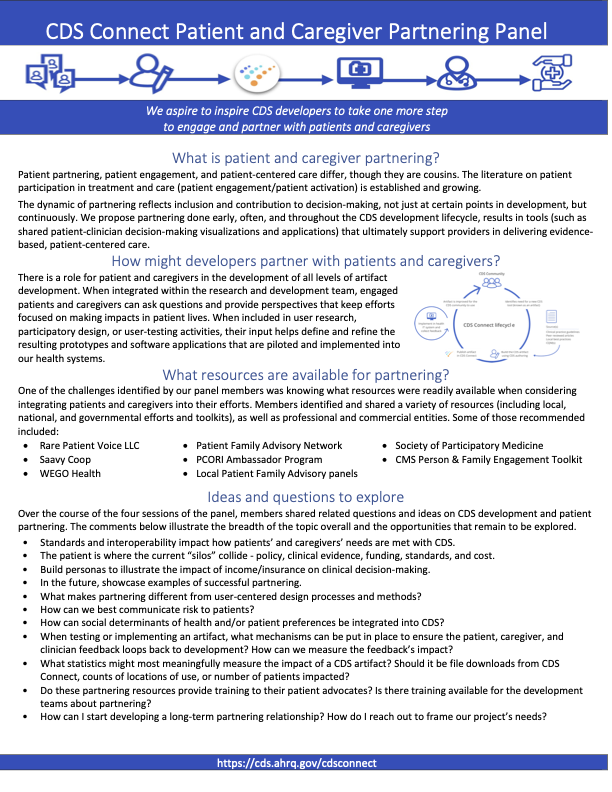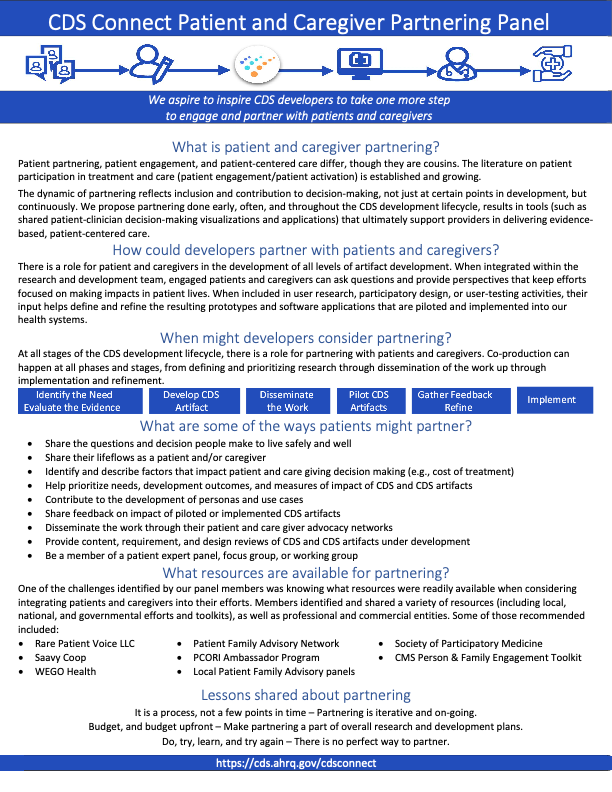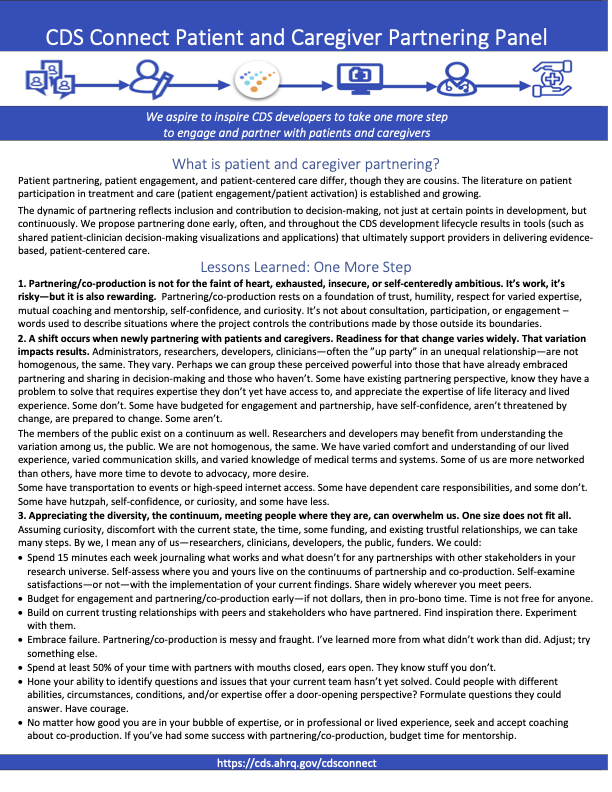We aspire to inspire CDS developers to take one more step to engage and partner with patients and caregivers
What is patient and caregiver partnering?Patient partnering, patient engagement, and patient-centered care are different, but interrelated concepts. The literature on patient participation in treatment and care (i.e., patient engagement/patient activation) is established and growing, while the idea of patient partnering in research, development and implementation is only beginning.
The dynamic of partnering reflects inclusion and contribution to decision-making, not just at certain points in a process, but continuously, with partnering done early, often, and throughout the CDS development lifecycle. This continuous engagement can result in tools, such as shared patient-clinician decision-making visualizations and applications, that ultimately support providers in delivering evidence-based, patient-centered care.
The topic of partnering with the patient and caregiver community was first raised during two Spring 2021 CDS Connect Work Group meetings.
- Discussion Part 1: Partnering with the Patient and Caregiver Community to Develop CDS (MITRE) (March 2021 Slides; March 2021 Notes)
- Discussion Part 2: Partnering with the Patient and Caregiver Community - Sharing Lessons Learned with CDS: Person-First Safe Living in a Pandemic (Danny van Leeuwen and Laura Haak Marcial) (April 2021 Slides; April 2021 Notes)
As a result, a subset of Work Group members joined together as an informal panel and met during the 2021 Summer months to explore the concept further. In four, interactive on-line sessions, panel members, AHRQ and MITRE staff, and the project's patient advocate explored the current state of patient partnering within the CDS development lifecycle. The discussions uncovered a need for guidance, resources, and use cases that could serve as tools to help CDS developers as they try to change their current approaches. The details of those sessions resulted in the three draft summary sheets - Topics to Explore; Panel Summary and Lessons Learned - seen below.
In subsequent CDS Connect Work Group meetings between December 2021 through April 2022, the Work Group aimed to expand upon the panel’s findings and provide members with the examples of others in the CDS space who have begun to take ‘one more step’ in patient and caregiver partnering. Participants shared their choice of user-centered methods, their challenges in partnering, and lessons learned through the partnering experience during the following Work Group sessions.
- December 2021 (December 2021 Slides, December 2021 Notes)
- Kick-off of "One More Step" in Patient Partnering, Michelle Lenox (MITRE)
- Round table discussion with AHRQ grantees - Chris Harle (University of Florida), David Dorr (OSHU), and Patty Dykes (Brigham and Woman's Hospital). Moderated by Danny van Leeuwan (HealthHats).
- February 2022 (February 2022 Slides, February 2022 Notes)
- ACTIVATE project (Katherine Kim, MITRE)
- Discussion about co-design for CDS development and implementation
- April 2022 (April 2022 Slides, April 2022 Notes)
- Round table and discussion on the Partnering Experience: Amy Price (Stanford); Danny van Leeuwen (HealthHats). Moderated by MITRE.
Topics to Explore
Panel Summary
Lessons Learned
Clinical decision support researchers, developers, and implementers this is for you. Clinical decision support (CDS) technology can maximize trust and engagement during informed decision-making if used to its full potential. Or NOT.
The mission of CDS Connect is to demonstrate how patient-centered outcomes research findings and evidence-based care are more rapidly incorporated into clinical practice through interoperable decision support. CDS Connect provides the ability to translate clinical practice guidelines into implementable clinical decision support (CDS) artifacts, which can be imported into an EHR. When used by clinicians or patients, these CDS tools can help improve clinician decision-making, support evidence-based practice, and ultimately, improve the quality of care provided to patients.
To provide the greatest benefit to clinicians and patients, clinical decision support must be developed to support individual patients, their caregivers, and care teams in health-related decisions and actions. Good CDS design must account for the clinical workflow, by providing the right information to the right people in the right formats through the right channels at the right time (“CDS 5 rights”) without overly interrupting the clinician workflow. Failure to include the right stakeholders, including clinicians, patients and their caregivers, early in the design and implementation process can limit the adoption and effectiveness of the clinical decision support.
Why and how should patients, their families and caregivers be involved in this process? First and foremost, the CDS must incorporate the values of patient-centered care, enabling patients and their clinicians to plan and manage the patient’s treatment and care together. Patient-centered CDS (PCCDS), defined as CDS that supports individual patients and their caregivers and/or care teams, can ultimately lead to improved patient outcomes and satisfaction. As a component of patient-centered care, CDS design and implementation should also account for the importance of the clinician-patient relationship, and the corresponding principles of trust and shared decision-making (SDM). In SDM, the patient’s perspective based on their values and preferences is critical to the decision-making process. It allows the patient and their healthcare provider to determine together the most appropriate treatment or care choice. The perspective of patients and their caregivers is a critical component in determining what works best in providing PCCDS that considers patient-specific values and preferences.
Ensuring that patients and their caregivers have a seat at the table during CDS research, design, development, testing, implementation and evaluation will help ensure that patient preferences as well as clinician and patient decision-making are supported. In turn, the successful implementation of CDS helps support quality and safety while also resulting in a positive impact to patient health outcomes and satisfaction.







